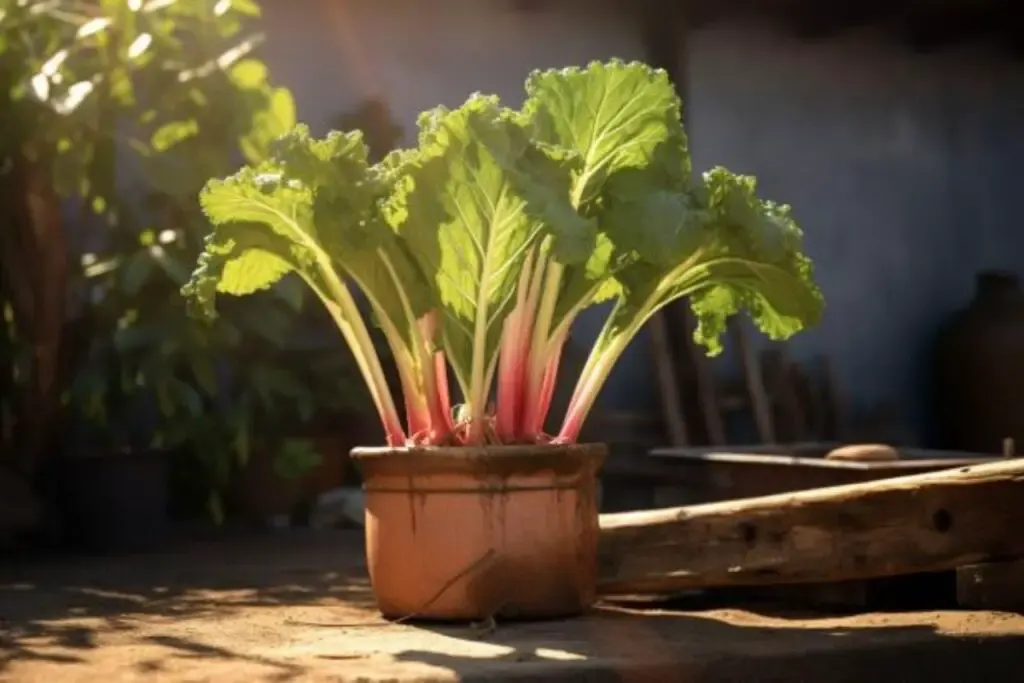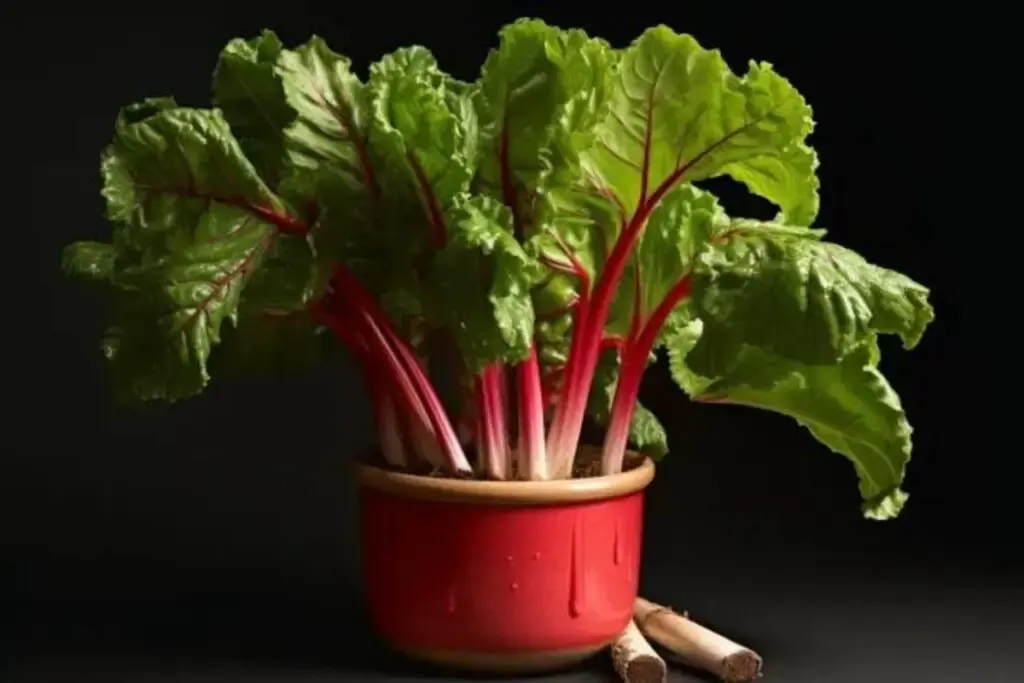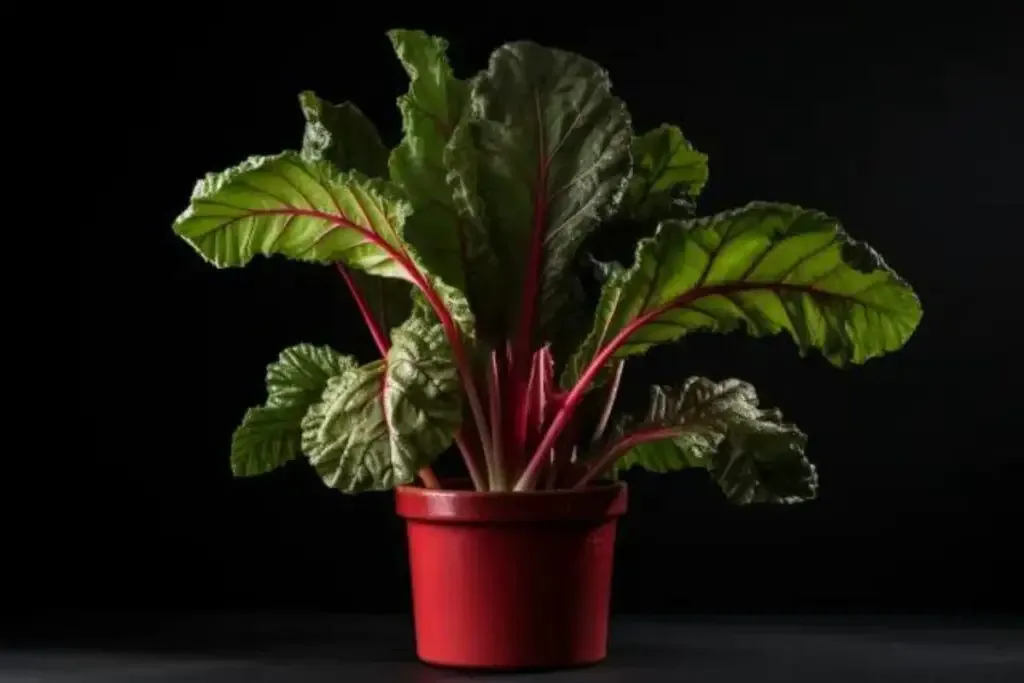Rhubarb: the vegetable that masquerades as a fruit in sweet culinary concoctions, with its tart flavor and vibrant red stalks. You might have visions of rhubarb sprawling across large garden patches, but did you know that with a little know-how, you can cultivate this perennial favorite in the compact comfort of a pot?
Whether you’re confined to a balcony garden or just prefer the tidiness of container gardening, growing rhubarb in pots is not only possible; it’s a delightful challenge with delicious rewards.
Let’s dig into the world of potted rhubarb and turn your urban space into a mini rhubarb reserve.
Does Rhubarb Grow Well in Pots?
The short answer is yes, rhubarb can thrive in pots, provided you meet its fairly simple needs. You see, rhubarb roots are quite robust; they like to spread out. This means that your success with potted rhubarb hinges on choosing a container that gives these vigorous roots room to grow.
A pot for rhubarb should be large, at least 20 inches in diameter, and deep enough to accommodate the plant’s substantial root system.
But there’s more to pot-grown rhubarb than just a big home. Rhubarb loves sunlight but appreciates a break from the heat in the height of summer afternoons. It also requires a well-draining soil mix and consistent watering to keep the soil moist but not waterlogged.
Achieve this balance, and you’ll be on your way to harvesting rhubarb stalks from the comfort of your patio or balcony.
Best Rhubarb Varieties for Pots
Not all rhubarb is created equal when it comes to container gardening. Some varieties are more suited to the confines of a pot, focusing their energy on producing plenty of stalks rather than expanding their territory. Let’s talk about a few top-performing rhubarb varieties that are tailor-made for pot life.
1. Victoria

The ‘Victoria’ rhubarb is something of a celebrity in the rhubarb world. It’s one of the oldest and most popular varieties, valued for its high yield and vigorous growth.
The stalks might not be as intensely red as some of the newer varieties, but they make up for it with their sweet and mellow flavor. ‘Victoria’ is an excellent choice for beginners because it’s less fussy about the transition from ground to pot.
2. MacDonald

Now, if you’re looking for that classic rhubarb tang and a deep red color that makes for gorgeous desserts, ‘MacDonald’ is your variety.
It’s a Canadian variety known for its brilliant red stalks and strong rhubarb flavor, which holds up beautifully in cooking. In pots, ‘MacDonald’ tends to grow more compactly, which means you won’t be sacrificing valuable balcony space for your tart treats.
3. Holsteiner Blut

Rounding out our trio is ‘Holsteiner Blut’, a German variety acclaimed for its striking appearance and robustness. The stalks are a deep ruby red, and the flavor is intense, ideal for those who enjoy the quintessential rhubarb sharpness.
This variety is particularly suited for cooler climates and can handle a bit of shade, making it a versatile choice for pot cultivation.
How to Grow and Care For Rhubarb in Pots
Growing rhubarb in containers may not be traditional, but it’s a fantastic solution for those with limited space who love this tart, versatile plant.
Here’s a comprehensive guide to help you become an expert at nurturing potted rhubarb.
Planting
When planting rhubarb in pots, timing and technique matter. Spring is the best time to plant rhubarb so it has a full season to establish itself. Begin with a rhubarb crown or a division from a healthy, mature plant.
Plant the crown so the top is just visible above the soil surface. This ensures that the bud isn’t buried too deep, which can hinder growth.
Pot Size
Rhubarb’s root system is extensive, which means pot size is paramount. Opt for a container that is at least 20 inches in diameter and equally deep.
This will provide adequate space for the roots to expand and prevent the plant from becoming pot-bound, which could drastically reduce your harvest.
Light
Rhubarb thrives in full sun, needing about 6-8 hours of sunlight daily for optimal growth. However, it benefits from some afternoon shade in hotter climates to prevent stress.
Properly balancing sun exposure and shade ensures vigorous growth and a rich harvest from your potted rhubarb.
Soil
The right soil mix is crucial for rhubarb. Use a well-draining, fertile mix rich in organic matter. Rhubarb thrives in slightly acidic to neutral soil with a pH between 6.0 and 6.8.
Good drainage is key to preventing root rot, so consider adding perlite or sand to enhance soil structure.
Watering
Consistent watering is key for rhubarb in pots, keeping the soil moist but not waterlogged. Water deeply when the top inch of soil feels dry, and ensure your pot has good drainage to avoid root rot.
Regular, even watering promotes healthy stalk growth and prevents the plant from drying out.
Temperature and Humidity
Rhubarb is a cool-season plant and does best in temperatures between 40°F and 75°F. It can tolerate some heat, but when the temperature starts to climb, providing some shade can help. As for humidity, rhubarb isn’t fussy, but it doesn’t like soggy conditions, so avoid over-humidifying the area.
Fertilizer
Feeding your rhubarb will encourage strong growth. Apply a balanced, slow-release fertilizer at the beginning of the growing season. Then, complement this with a high-nitrogen feed early in spring to support leaf development, and switch to a phosphorus-rich feed when the plant starts to flower to promote root health.
Pruning Potted Rhubarb
Pruning is a key element in the care of rhubarb, particularly when grown in pots. As a seasoned gardener, I’ve learned that regular pruning not only helps to maintain the plant’s vitality but also encourages a more robust yield.
The process is straightforward: remove any flower stalks as soon as they appear. This redirects the plant’s energy from seed production back to leaf and stem growth, which is what we’re after for that delectable harvest.
Additionally, at the end of the season, remove any old or damaged leaves to keep your plant healthy and to deter any pests or diseases from taking up residence over the winter.
Overwintering
Overwintering rhubarb in pots requires some attention, but with the right approach, your plants can thrive year after year. Here’s how to ensure your rhubarb gets through the colder months:
- Insulate: As temperatures drop, your rhubarb’s roots are at risk. Insulate the pot with bubble wrap, burlap, or even a thick layer of mulch to protect against freeze-thaw cycles that can damage the roots.
- Location: Move your potted rhubarb to a sheltered location, such as against a garden wall or in a garage where it remains cold but frost-free. This stimulates the dormant period rhubarb needs without the risk of freezing solid.
- Watering: Reduce watering significantly during the winter, but do not allow the soil to become bone dry. The goal is to keep the rhubarb dormant without letting it dehydrate completely.
- Trimming: Cut back the leaves after they’ve died down in the fall. This tidies up the plant and removes any material that could harbor pests or diseases over the winter.
Come spring, your rhubarb should emerge from its winter rest ready to grow vigorously, providing another season of tart, flavorful stalks for pies, jams, and more.
Remember, rhubarb grown in pots will require some extra care compared to those planted in the ground, but the reward of fresh rhubarb is well worth the effort.

